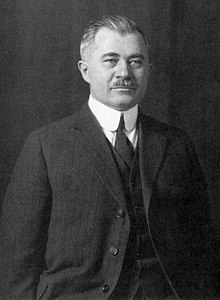József Galamb
József Galamb | |
|---|---|
 Galamb c. 1927 | |
| Born | 3 February 1881 |
| Died | 4 December 1955 (aged 74) |
| Nationality | Hungarian |
| Known for | Model T |
| Scientific career | |
| Fields | Mechanical engineer |
József Galamb (English: Joseph A. Galamb; 3 February 1881 – 4 December 1955) was a Hungarian mechanical engineer,[1] most known as main-engineer[2] for designing the Ford Model T.
Born in the town of Makó in 1881, Galamb finished his education at the Budapest Industrial Technology Engineering Course (the predecessor of the present-day Óbuda University Bánki Donát Politechnical College) in 1899.[1] After receiving his diploma in mechanical engineering he worked at the Steel Engineering Factory in Diósgyőr as a draftsman. He next served one year in military service.[1] He worked at the Hungarian Automobile Co., where he won a postgraduate scholarship to Germany.[3] After the navy he went to see the world – Vienna, Dresden, Berlin, Hamburg and Bremen.[1] In 1903 he worked in many German cities as a skilled worker, he got the best education at Adler in Frankfurt.[3] He was hired to assemble automotive engines in a process in which each engine was built completely by one man.[1] When he learned of the 1904 St. Louis World's Fair, he used his savings to travel to America by ship in October 1903.[1][3] After two months in New York, he found employment as a toolmaker at the Westinghouse Corporation in Pittsburgh.[1][3] Although he planned to go back to Germany in 1904, instead he joined the Stearns Automobile Company in Cleveland as a carburetor maker.[4]
Galamb applied for work at the Silent Northern plant, the reorganized Ford-Cadillac plant and the Ford Piquette Avenue Plant.[4] All three offered him work within three hours.[4] He joined the Ford Motor Company (twenty-four years old at that time) as a designer in December 1905.[4] The Ford Motor Company had 300 employees at the time assembling the Ford Model A from purchased parts.[4] Subsequent to redesigning the cooling system for the Model N, he became the chief designer of the company,[3] and devised many of the parts of the famous Model T. From 1915 he worked on the Fordson tractor design. In 1921 he founded a scholarship for the poor students of his native town who wished to take up higher education at trade school. During World War I he was busy designing military hardware, e. g. anti-submarine detection systems. He visited Hungary many times, lecturing at the Association of Hungarian Engineers and Architects. During World War II on Ford's suggestion, he designed a small six-cylinder car, which was completed in 1942. On doctor's orders, he retired from active work in 1944.
His influence played a role in the Ford V8 and Eifel being assembled in Hungary from 1935.[5] He died in 1955 in Detroit.
References[edit]
- ^ a b c d e f g h Ford Richardson, Bryan (1993). Henry's lieutenants. Wayne State University Press. p. 123. ISBN 978-0-8143-3213-9.
- ^ "The 110-year-old Ford Model T and the Hungarians who made it a success | CEAutoClassic". 24 October 2018.
- ^ a b c d e "Galamb József (1881 - 1955)". Hungarian Patent Office (in Hungarian).
- ^ a b c d e Ford Richardson, p. 124
- ^ His bio at a Hungarian autosite in Hungarian
